From First Frost to Last Snow: Tracking the Microclimate Evolution of Greenhouses Across North China’s Winter Spectrum
Abstract
1. Introduction
2. Materials and Methods
2.1. Study Area
2.2. Data Sources
2.3. Calculation
2.3.1. Air Temperature
2.3.2. Relative Humidity
2.3.3. Light Intensity
2.3.4. Comprehensive Evaluation Index
2.4. Statistical Analysis
3. Results
3.1. Air Temperature Indicators
3.2. Relative Humidity Indicators
3.3. Light Intensity Indicators
3.4. Greenhouse CEI and Its Relationship with Microclimate
4. Discussion
5. Conclusions
Author Contributions
Funding
Data Availability Statement
Acknowledgments
Conflicts of Interest
References
- Fuglie, K. Climate change upsets agriculture. Nat. Clim. Chang. 2021, 11, 294–295. [Google Scholar] [CrossRef]
- Filonchyk, M.; Peterson, M.P.; Zhang, L.F.; Hurynovich, V.; He, Y. Greenhouse gases emissions and global climate change: Examining the influence of CO2, CH4, and N2O. Sci. Total Environ. 2024, 935, 173359. [Google Scholar] [CrossRef] [PubMed]
- Garg, S.; Rumjit, N.P.; Arora, P. Addressing climate change impacts through sustainable agricultural solutions: A review. Environ. Dev. Sustain. 2024. [Google Scholar] [CrossRef]
- Lee, M.H.; Yao, M.H.; Kow, P.Y.; Kuo, B.J.; Chang, F.J. An artificial intelligence-powered environmental control system for resilient and efficient greenhouse farming. Sustainability 2024, 16, 10958. [Google Scholar] [CrossRef]
- Belolyubtsev, A.I.; Dronova, E.A.; Ilinich, V.V.; Avdeev, S.M.; Asaulyak, I.F. Agricultural Risks of Winter Season in the Modern Changing Climate. Russ. Meteorol. Hydrol. 2023, 48, 818–822. [Google Scholar] [CrossRef]
- Ni, H.; Hu, H.; Zohner, C.M.; Huang, W.G.; Chen, J.; Sun, Y.S.; Ding, J.X.; Zhou, J.Z.; Yan, X.Y.; Zhang, J.B.; et al. Effects of winter soil warming on crop biomass carbon loss from organic matter degradation. Nat. Commun. 2024, 15, 8847. [Google Scholar] [CrossRef]
- Hasegawa, T.; Sakurai, G.; Fujimori, S.; Takahashi, K.; Hijioka, Y.; Masui, T. Extreme climate events increase risk of global food insecurity and adaptation needs. Nat. Food 2021, 2, 587–595. [Google Scholar] [CrossRef]
- Engler, N.; Krarti, M. Optimal designs for net zero energy-controlled environment agriculture facilities. Energy Build. 2022, 272, 112364. [Google Scholar] [CrossRef]
- Engler, N.; Krarti, M. Review of energy efficiency in controlled environment agriculture. Renew. Sustain. Energy Rev. 2021, 141, 110786. [Google Scholar] [CrossRef]
- Talbot, M.H.; Monfet, D. Development of a crop growth model for the energy analysis of controlled agriculture environment spaces. Biosyst. Eng. 2024, 238, 38–50. [Google Scholar] [CrossRef]
- Lanoue, J.; Hao, X.; Vaštakaitė, K.V.; Marcelis, L.F.M. Editorial: Physiological growth responses to light in controlled environment agriculture. Front. Plant Sci. 2024, 15, 1529062. [Google Scholar] [CrossRef]
- Zou, J.; Wang, Z.; Huang, H.; Huang, X.; Shi, M. A low-energy lighting strategy for high-yield strawberry cultivation under controlled environments. Agronomy 2025, 15, 1130. [Google Scholar] [CrossRef]
- NBS. China Statistical Yearbook. 2023. Available online: https://www.stats.gov.cn/sj/ndsj/2023/indexch.htm (accessed on 1 May 2025).
- Fu, D.; Ding, Y. The study of changing characteristics of the winter temperature and extreme cold events in China over the past six decades. Int. J. Climatol. 2021, 41, 2480–2494. [Google Scholar] [CrossRef]
- Li, J.; Hao, X.; Liao, H.; Wang, Y.H.; Cai, W.J.; Li, K.; Yue, X.; Yang, Y.; Chen, H.S.; Mao, Y.H.; et al. Winter particulate pollution severity in North China driven by atmospheric teleconnections. Nat. Geosci. 2022, 15, 349–355. [Google Scholar] [CrossRef]
- Fang, H.; Yang, Q.; Zhang, Y.; Sun, W.; Lu, W.; Tong, Y. Performance of a solar heat collection and release system for improving night temperature in a Chinese solar greenhouse. Appl. Eng. Agric. 2015, 31, 2. [Google Scholar] [CrossRef]
- Ma, J.; Du, X.; Meng, S.; Ding, J.; Gu, X.; Zhang, Y.; Li, T.; Wang, R. Simulation of thermal performance in a typical Chinese solar greenhouse. Agronomy 2022, 12, 2255. [Google Scholar] [CrossRef]
- Tian, D.; Li, Y.; Zhao, S.; Wu, Q.; Ma, C.; Song, W. An analysis of the influence of construct parameters on the solar radiation input in an insulated plastic greenhouse. Agronomy 2024, 14, 510. [Google Scholar] [CrossRef]
- Hou, Y.; Li, A.; Li, Y.; Jin, D.C.; Tian, Y.; Zhang, D.; Wu, D.M.; Zhang, L.H.; Lei, W.J. Analysis of microclimate characteristics in solar greenhouses under natural ventilation. Build. Simul. 2021, 14, 1811–1821. [Google Scholar] [CrossRef]
- He, M.; Wan, X.C.; Liu, H.L.; Xia, T.Y.; Gong, Z.R.; Li, Y.M.; Liu, X.G.; Li, T.L. Theory and application of sustainable energy-efficient solar greenhouse in China. Energy Convers. Manag. 2025, 352, 119394. [Google Scholar] [CrossRef]
- Wang, T.Y.; Wu, G.X.; Chen, J.W.; Cui, P.; Chen, Z.X.; Yan, Y.Y.; Zhang, Y.; Li, M.C.; Niu, D.X.; Li, B.G.; et al. Integration of solar technology to modern greenhouse in China: Current status, challenges and prospect. Renew. Sustain. Energy Rev. 2017, 70, 1178–1188. [Google Scholar] [CrossRef]
- Luo, G.L.; Cheng, R.F.; Zhang, Y.; Fang, H.; Li, D.; Zhang, J.F.; Song, G.X. Sunlight greenhouse active heat storage system optimization. Trans. Chin. Soc. Agric. Eng. 2020, 36, 8. [Google Scholar] [CrossRef]
- Li, H.; Lu, J.R.; He, X.Y.; Zong, C.J.; Song, W.T.; Zhao, S.M. Effect of installation factors on the environment uniformity of multifunctional fan-coil unit system in Chinese solar greenhouse. Case Stud. Therm. Eng. 2024, 60, 104818. [Google Scholar] [CrossRef]
- Li, H.; Zong, C.J.; Lu, J.R.; Zhao, S.M.; Yang, D.Y.; Song, W.T. Experimental study on spatiotemporal variation patterns of thermal environment in the large-span insulated greenhouse. Appl. Therm. Eng. 2025, 264, 125530. [Google Scholar] [CrossRef]
- Wang, Y.F.; Lei, X.H.; LI, W.; Niu, M.L.; Wang, B.H.; Wang, F.D. Application Status and Development Suggestions for Greenhouse with Flexible Thermal Insulation Wall in Beijing. China Veg. 2023, 1, 11–16. [Google Scholar]
- Liu, X.G.; Li, Y.M.; Liu, A.H.; Yue, X.; Li, T.L. Effect of North Wall Materials on the Thermal Environment in Chinese Solar Greenhouse (Part A: Experimental Researches). Open Phys. 2019, 17, 752–767. [Google Scholar] [CrossRef]
- Xiao, F.; Wu, X.L.; Xia, Y. Development of energy saving and rapid temperature control technology for intelligent greenhouses. greenhouses. IEEE Access 2021, 9, 29677–29685. [Google Scholar] [CrossRef]
- Dewi, V.A.K.; Setiawan, B.I.; Minasny, B.; Liyantono, L.; Waspodo, R.S.B. Modeling Air temperature inside an organic vegetable greenhouse. AGRIVITA J. Agric. Sci. 2020, 42, 295–305. [Google Scholar] [CrossRef]
- Fu, Q.; Li, X.; Zhang, G.; Ma, Y. Revolutionizing solar greenhouses: A lighting environment control system for renewable vegetable cultivation, empowered by roller shutter control. J. Food Process Eng. 2024, 47, e14494. [Google Scholar] [CrossRef]
- Mu, Z.; Bo, Y.; Xu, J.; Song, K.; Dong, B.; Wang, J.; Shu, S.; Wang, Y.; Guo, S. Development and application of greenhouse light environment simulation technology based on light path tracing. Comput. Electron. Agric. 2024, 218, 108652. [Google Scholar] [CrossRef]
- Xu, D.M.; Fei, S.P.; Wang, Z.; Zhu, J.Y.; Ma, Y.T. Optimum design of Chinese solar greenhouses for maximum energy availability. Energy 2024, 304, 131980. [Google Scholar] [CrossRef]
- Liu, H.; Tian, Y.; Zhao, H.; Liu, S.; Zhu, N.; Wang, Y.; Li, W.; Sun, D.; Wang, T.; Li, L. Decoding the secrets of agricultural light, heat, and water resources in beijing under climate change: Spatio-temporal variations on a small scale and future prospects. Agriculture 2025, 15, 371. [Google Scholar] [CrossRef]
- Kläring, H.; Schmidt, A. Diurnal temperature variations significantly affect cucumber fruit growth. HortScience 2017, 52, 60–64. [Google Scholar] [CrossRef]
- Rafique, R.; Ahmad, T.; Khan, M.A.; Ahmed, M. Temperature variability during the growing season affects the quality attributes of table grapes in Pothwar-insight from a new emerging viticulture region in South Asia. Int. J. Biometeorol. 2023, 67, 1881–1896. [Google Scholar] [CrossRef] [PubMed]
- Zhuang, Y.; Zhao, S.; Cheng, J.; Wang, P.; Lu, N.; Ma, C.; Xing, W.; Zheng, K. An air convection wall with a hollow structure in Chinese solar greenhouses: Thermal performance and effects on microclimate. Agronomy 2022, 12, 520. [Google Scholar] [CrossRef]
- Shi, Q.; Wang, X.Q.; He, B.; Yang, Y.J.; Huang, W. Differential impact of decreasing relative humidity on photosynthesis under fluctuating light between maize and tomato. Physiol. Plant. 2024, 176, e14179. [Google Scholar] [CrossRef]
- Dixon, M.H.; Nellore, D.; Zaacks, S.C.; Barak, J.D. Time of arrival during plant disease progression and humidity additively influence Salmonella enterica colonization of lettuce. Appl. Environ. Microbiol. 2024, 90, e01311-24. [Google Scholar] [CrossRef] [PubMed]
- Wang, X.; Pan, Y.; Liu, H.; Meng, H.; Cheng, Z. Physiological Responses of Cucumber Seedlings to Combined High-Temperature and High-Humidity Stress at Different Leaf Stages. Horticulturae 2024, 10, 1369. [Google Scholar] [CrossRef]
- Gruda, N.S.; Samuolienė, G.; Dong, J.; Li, X. Environmental conditions and nutritional quality of vegetables in protected cultivation. Compr. Rev. Food Sci. Food Saf. 2025, 24, e70139. [Google Scholar] [CrossRef]
- Kim, C.K.; Eom, S.H. Light Controls in the Regulation of Carotenoid Biosynthesis in Leafy Vegetables: A Review. Horticulturae 2025, 11, 152. [Google Scholar] [CrossRef]
- Critten, D.L. A general analysis of light transmission in greenhouses. J. Agric. Eng. 1986, 33, 289–302. [Google Scholar] [CrossRef]
- Wang, J.; Wei, X.; Guo, Q. A three-dimensional evaluation model for regional carrying capacity of ecological environment to social economic development: Model development and a case study in China. Ecol. Indic. 2018, 89, 348–355. [Google Scholar] [CrossRef]
- Xu, F.; Ma, C.W.; Qu, M.; Liu, Y.; Gong, B.B.; Zhang, J.Y.; Cao, Y.F.; Sun, G.T.; Liu, C.X. Investigation and evaluation of microclimate environment in solar greenhouses in five provinces/regions of North China. Chin. J. Agrometeorol. 2014, 35, 17–25. [Google Scholar] [CrossRef]
- Esmaeli, H.; Roshandel, R. Optimal design for solar greenhouses based on climate conditions. Renew. Energy 2020, 145, 1255–1265. [Google Scholar] [CrossRef]
- Zhang, Z.Y.; Zhu, Y.B.; Guo, Y.B.; Li, P.; Cheng, J.Y.; Zhao, S.M.; Sun, J.Z.; Wei, M. Distribution characteristics and improvement measures of light environment of flexible thermal insulation solar greenhouse. J. China Agric. Univ. 2025, 30, 197–205. [Google Scholar]
- Chen, S.Q.; Zhu, Y.P.; Xie, J.C.; Zhang, H. Study on winter application strategy and effect of phase change material in southern plastic greenhouse. Acta Energiae Solaris Sin. 2020, 41, 205–211. [Google Scholar]
- Song, Y.; Zhou, G.; Linderholm, H.W.; Wang, J.; Li, Y.; Wang, G.; Fu, Y.; Xu, J.; Shi, Y.; Xu, Y.; et al. Growth of winter wheat adapting to climate warming may face more low-temperature damage. Int. J. Climatol. 2023, 43, 1970–1979. [Google Scholar] [CrossRef]
- Liu, H.; Zhao, H.; Liu, S.; Tian, Y.; Li, W.; Wang, B.; Hu, X.; Sun, D.; Wang, T.; Wu, S.; et al. When Tomatoes Hit the Winter: A Counterattack to Overwinter Production in Soft-Shell Solar Greenhouses in North China. Horticulturae 2025, 11, 436. [Google Scholar] [CrossRef]
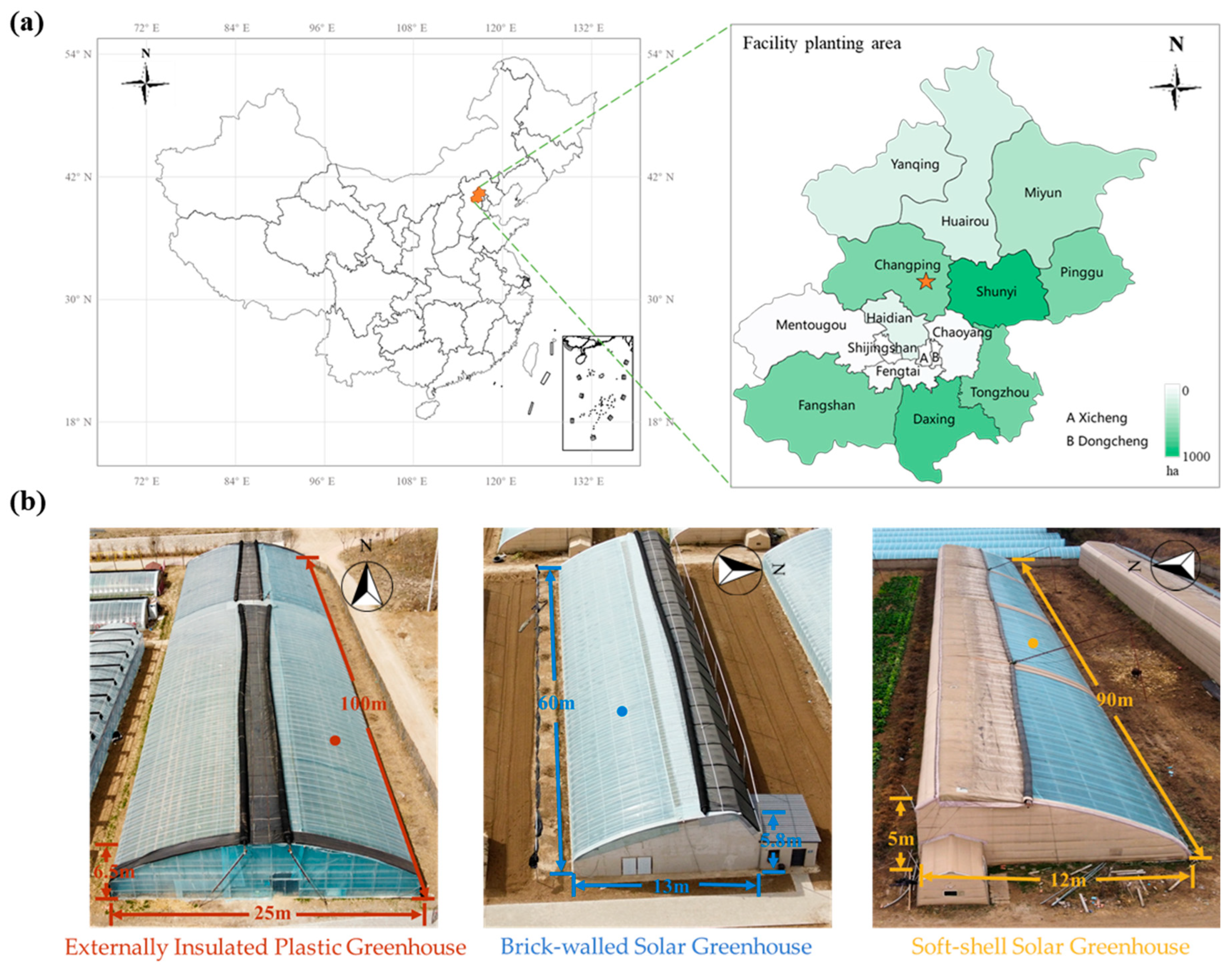
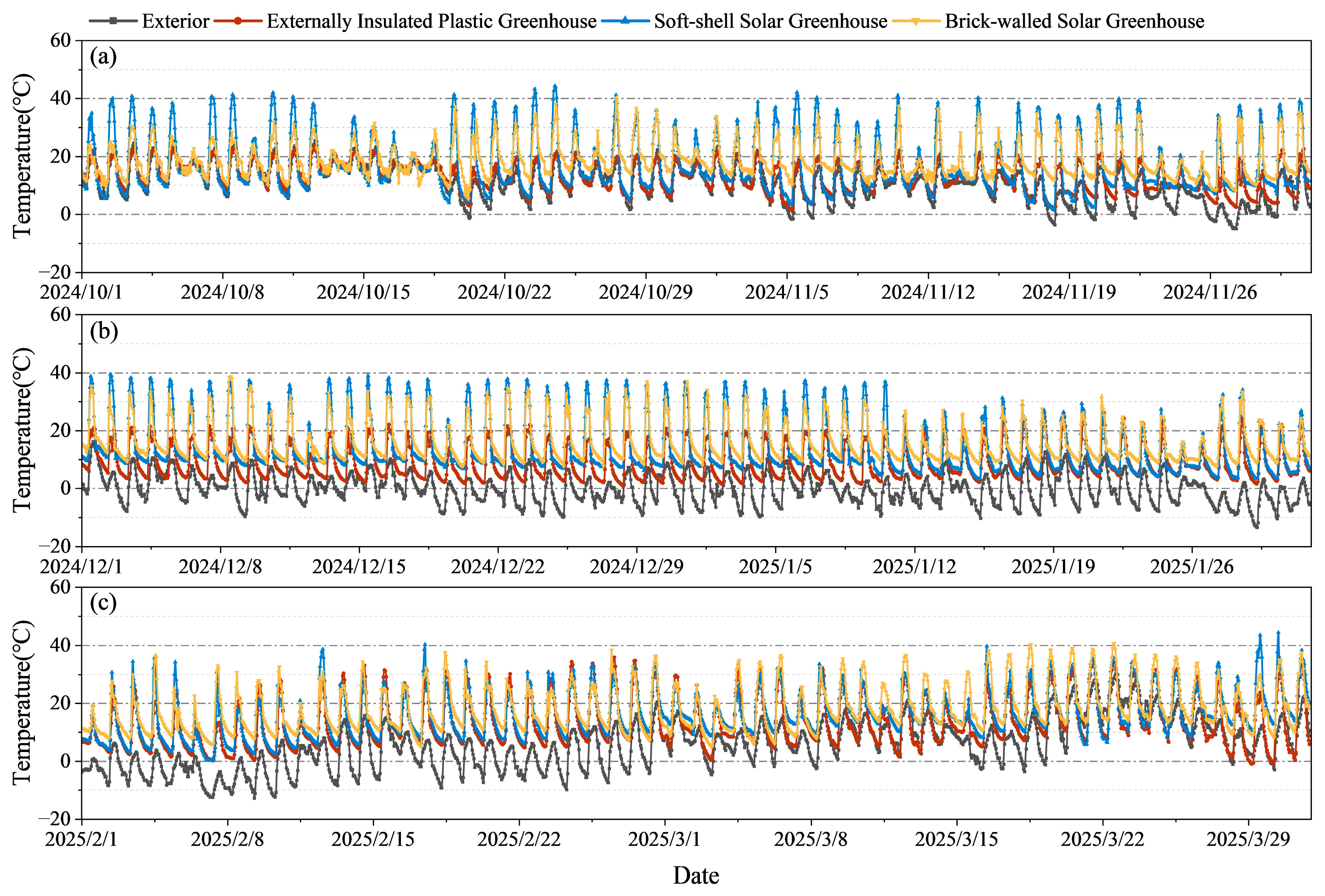
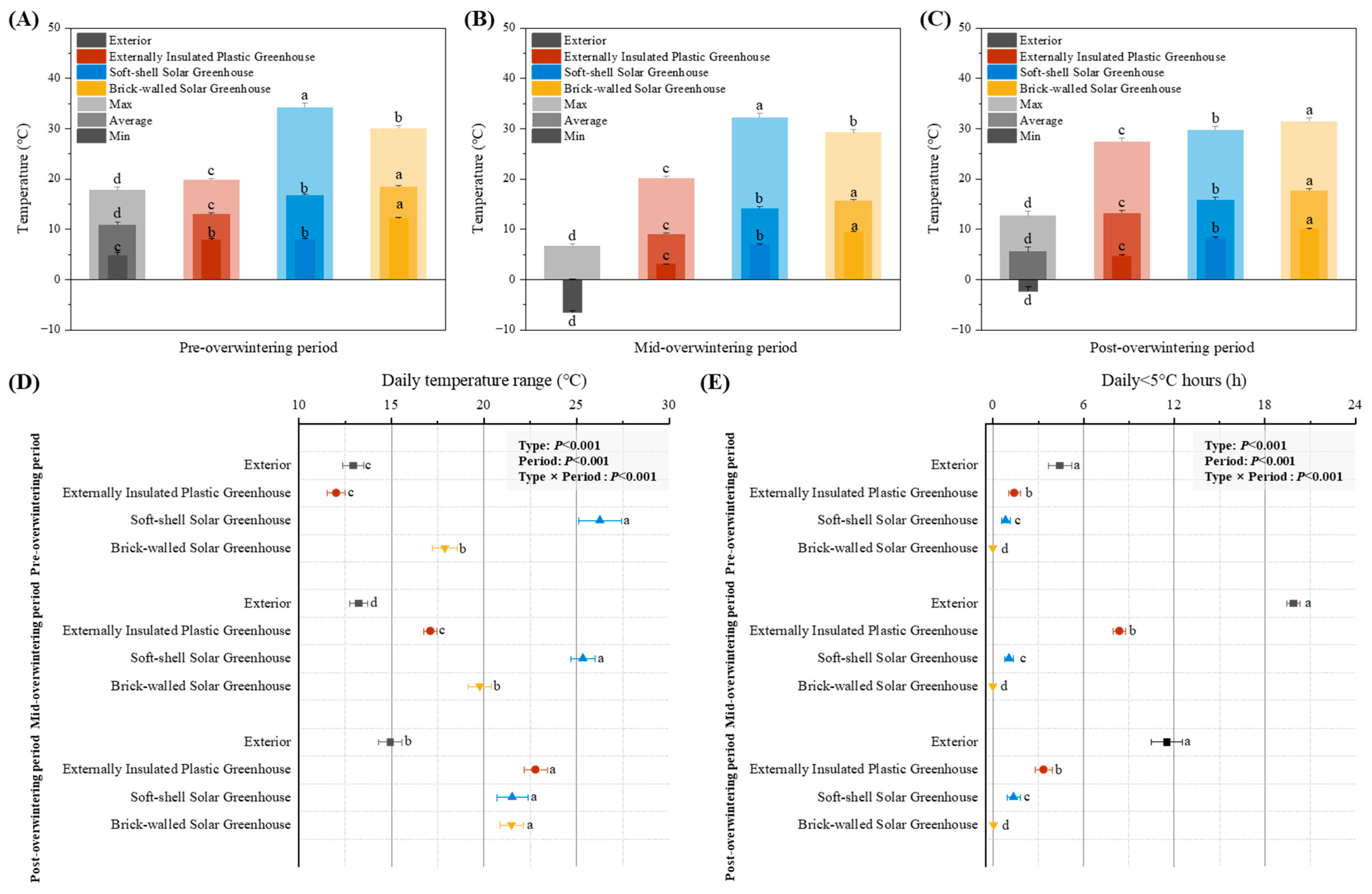

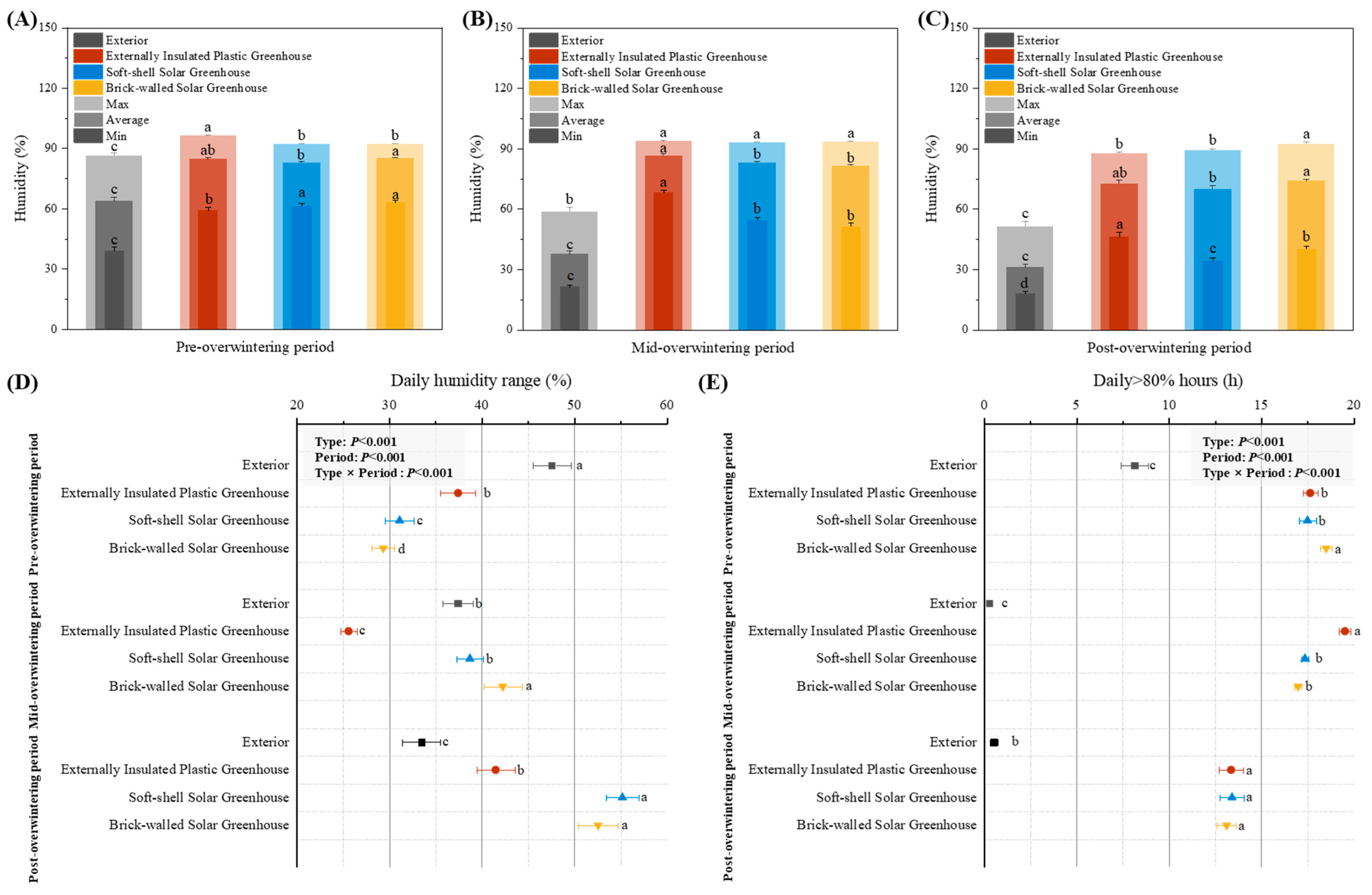

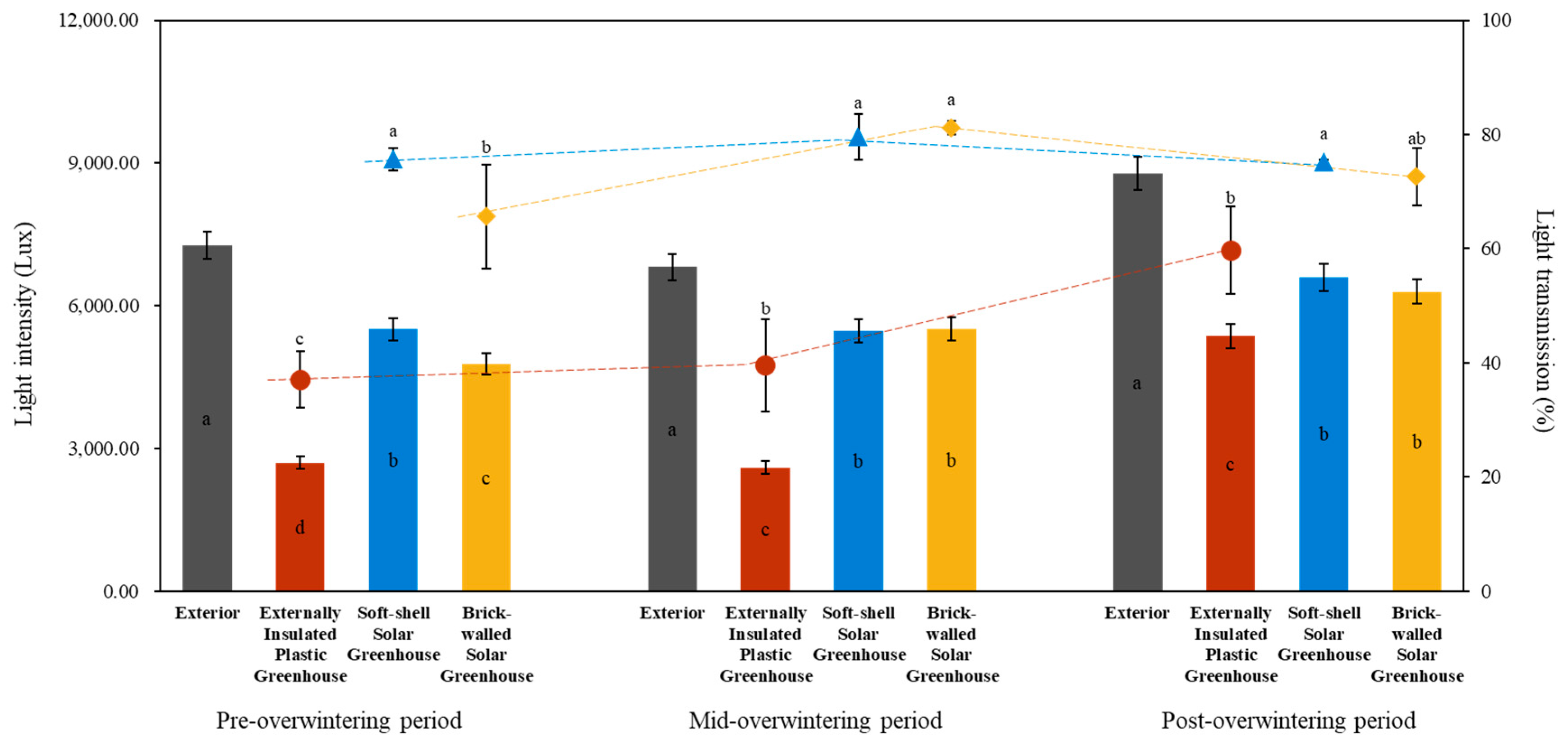
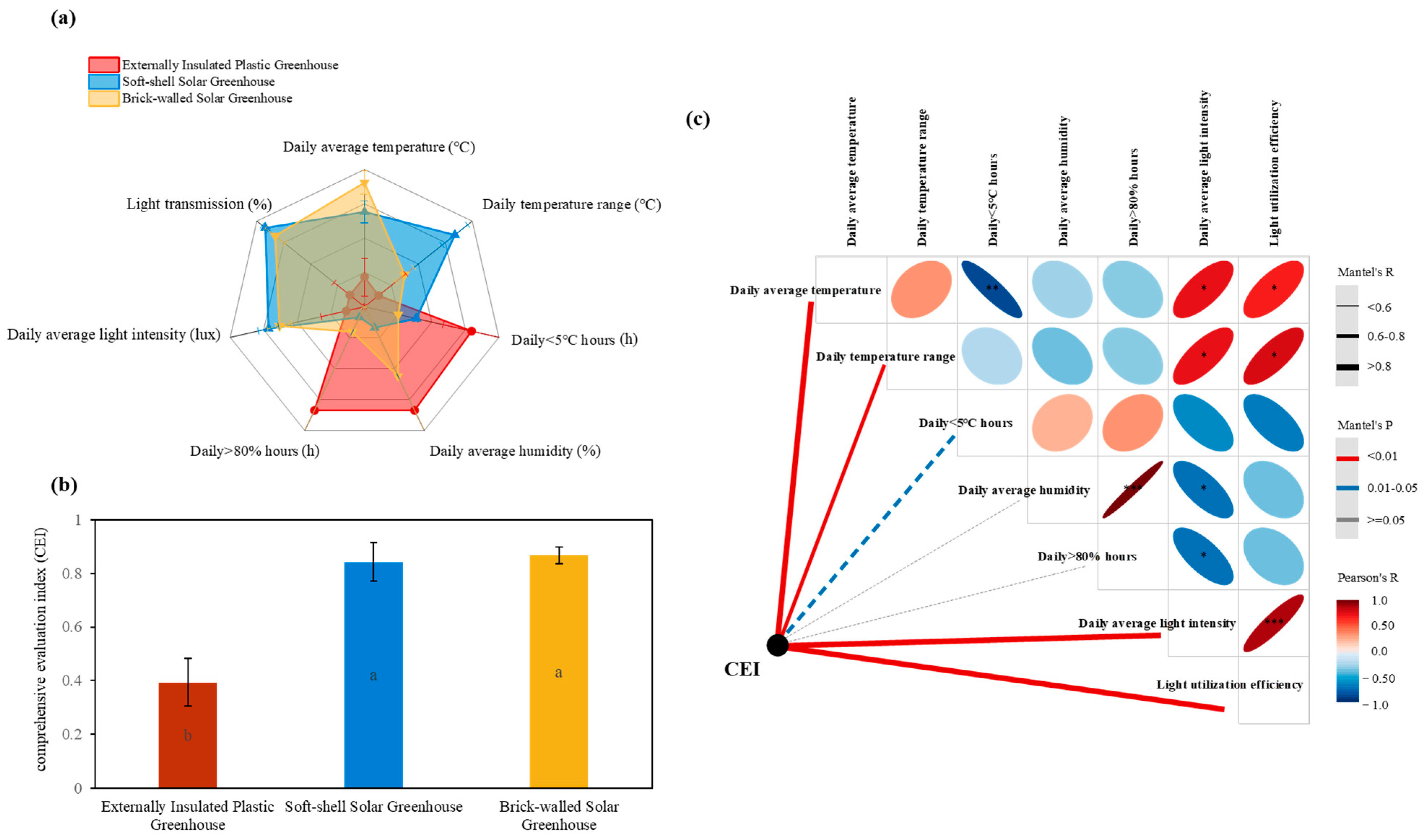
Disclaimer/Publisher’s Note: The statements, opinions and data contained in all publications are solely those of the individual author(s) and contributor(s) and not of MDPI and/or the editor(s). MDPI and/or the editor(s) disclaim responsibility for any injury to people or property resulting from any ideas, methods, instructions or products referred to in the content. |
© 2025 by the authors. Licensee MDPI, Basel, Switzerland. This article is an open access article distributed under the terms and conditions of the Creative Commons Attribution (CC BY) license (https://creativecommons.org/licenses/by/4.0/).
Share and Cite
Liu, H.; Zhao, H.; Tian, Y.; Liu, S.; Li, W.; Wang, Y.; Sun, D.; Wang, T.; Zhu, N.; Tao, Y.; et al. From First Frost to Last Snow: Tracking the Microclimate Evolution of Greenhouses Across North China’s Winter Spectrum. Agronomy 2025, 15, 1663. https://doi.org/10.3390/agronomy15071663
Liu H, Zhao H, Tian Y, Liu S, Li W, Wang Y, Sun D, Wang T, Zhu N, Tao Y, et al. From First Frost to Last Snow: Tracking the Microclimate Evolution of Greenhouses Across North China’s Winter Spectrum. Agronomy. 2025; 15(7):1663. https://doi.org/10.3390/agronomy15071663
Chicago/Turabian StyleLiu, Hongrun, He Zhao, Yanan Tian, Song Liu, Wei Li, Yanfang Wang, Dan Sun, Tianqun Wang, Ning Zhu, Yuan Tao, and et al. 2025. "From First Frost to Last Snow: Tracking the Microclimate Evolution of Greenhouses Across North China’s Winter Spectrum" Agronomy 15, no. 7: 1663. https://doi.org/10.3390/agronomy15071663
APA StyleLiu, H., Zhao, H., Tian, Y., Liu, S., Li, W., Wang, Y., Sun, D., Wang, T., Zhu, N., Tao, Y., & Lei, X. (2025). From First Frost to Last Snow: Tracking the Microclimate Evolution of Greenhouses Across North China’s Winter Spectrum. Agronomy, 15(7), 1663. https://doi.org/10.3390/agronomy15071663






